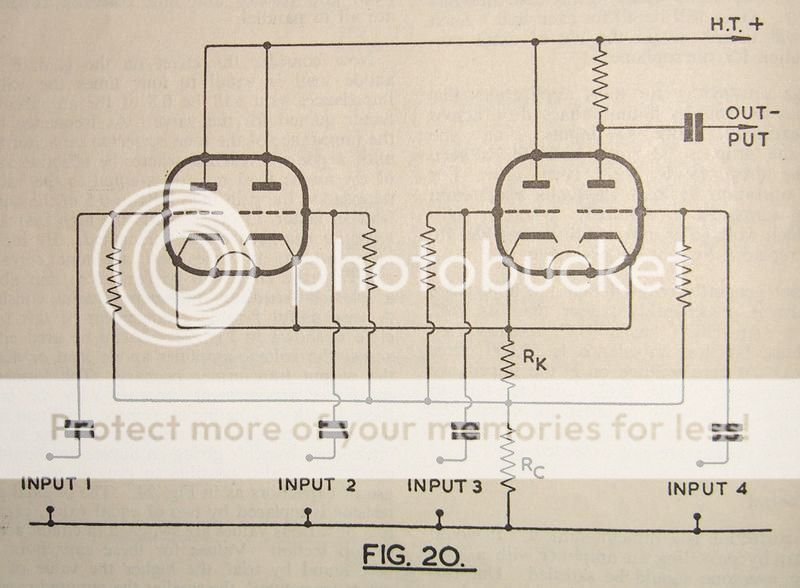When I think of triode AF mixers, I think of something like this - a common anode mixer. Example here. https://www.ampbooks.com/mobile/classic-circuits/gretsch-chet-atkins-mixer/
OK as a mixer but not the lowest output impedance for say driving tone stacks, though a low plate resistance (low mu) tube can help.
Conversely, for driving lower impedance loads I think of cathode followers - Example here.
https://www.ampbooks.com/mobile/amplifier-calculators/cathode-follower/
I'm looking to design a triode mixer that takes two inputs - one from a 6SJ7 pentode and one from a 6SQ7 triode - both first stage pre-amp tubes for guitar use and each with their own independent volume control. These would then be mixed (in a pair of triodes) that onward drive a tone stack (type yet to be decided).
Does anyone know if is possible to create a dual, shared cathode, cathode follower? - combining a mixer and cathode follower in one? In this design the output of each first stage tube would connect to the grid of its associated follower but both followers would share a common anode connection and cathode resistor with the output taken at the cathode in the normal way (for a cathode follower).
And then further refine by adopting Merlins DC coupling approach to cathode followers here.The Valve Wizard[/URL]
OK as a mixer but not the lowest output impedance for say driving tone stacks, though a low plate resistance (low mu) tube can help.
Conversely, for driving lower impedance loads I think of cathode followers - Example here.
https://www.ampbooks.com/mobile/amplifier-calculators/cathode-follower/
I'm looking to design a triode mixer that takes two inputs - one from a 6SJ7 pentode and one from a 6SQ7 triode - both first stage pre-amp tubes for guitar use and each with their own independent volume control. These would then be mixed (in a pair of triodes) that onward drive a tone stack (type yet to be decided).
Does anyone know if is possible to create a dual, shared cathode, cathode follower? - combining a mixer and cathode follower in one? In this design the output of each first stage tube would connect to the grid of its associated follower but both followers would share a common anode connection and cathode resistor with the output taken at the cathode in the normal way (for a cathode follower).
And then further refine by adopting Merlins DC coupling approach to cathode followers here.The Valve Wizard[/URL]
Yes you can do that. This example takes the output from an anode, but it could be taken across Rc.


Thanks Merlin. With respect to DC coupling, would it be correct to assume it would not be possible to bootstrap the dual followers for more gain in this circumstance (due to the mixer approach and different tube types involved)
Correct.it would not be possible to bootstrap the dual followers for more gain in this circumstance (due to the mixer approach and different tube types involved)
- Status
- Not open for further replies.